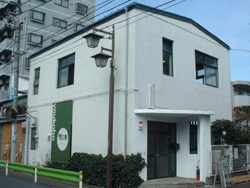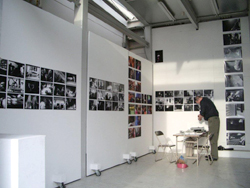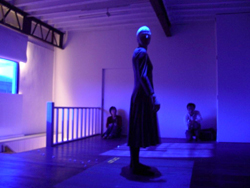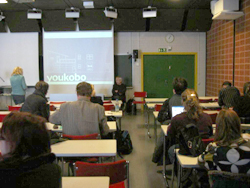

Tatsuhiko Murata, Co-Director, Youkobo Art Space
I. Outline of Youkobo Art Space
Youkobo Art Space is a comprehensive art facility comprised of a gallery, working studios, and residential spaces. In particular, the Youkobo Artist-in-Residence program not only provides overseas artists with an opportunity to expand the scope of their activities in the unique and exciting metropolis of Tokyo, it also provides the people of the area with an opportunity to experience and enjoy a variety of genres of contemporary art. Up to the 1970s, the building that is now Youkobo Art Space was a clinic and sanatorium, and it has served as a space for a variety of art activities since the 1980s.
The Youkobo Art Community is a wide range of community activities centered on Youkobo Art Space, whose comprehensive art facility provides a platform for the cultivation, development, refinement, and transformation of diverse modes of artistic activity and communication. The fruits of this activity are seen in gallery exhibitions, contact among overseas and Japanese artists, and in art-related events in the local community and beyond.

1) Artist-in-Residence at Youkobo Art Space
Youkobo Art Space provides a place for both Japanese and foreign artists to use a residency as an opportunity to engage in new creative work. The AIR program is designed to offer fine-tuned and flexible support to the diverse individual needs of the artist, and to respect the artists’ wishes with regard to how they are to spend their residency. Artists have a variety of reasons for wanting to do a residency in Tokyo to produce and show their work, to participate in a project, to do research or study, to experience the art scene in Tokyo and Japan as a whole. We provide a place for daily living and communication geared to make their activities and work go as smoothly as possible. The program provides working studios and residential space on a rental basis. The residential accommodations are furnished with the necessities of daily life, and equipped with broadband Internet access via a LAN system. More specialized and personal support may also be available through our network of contacts among artists and the local community. We are prepared to serve as a liaison with local art groups and related institutions in terms of facilitating studio work, workshops, lectures, and other events, depending on the interests of the artists. For showing work, open studio or gallery exhibitions are possible.


2)Gallery Exhibitions
A gallery space is available for exhibiting the work of Japanese and foreign artists and for other artistic activity. The artists themselves are responsible for organizing and presenting the show, documenting it, taking it down, and restoring the gallery to its original condition. We do offer managerial assistance to younger artists with exhibition proposals.

3) Community Lounge
Connected to the Gallery is the Community Lounge, a comfortable space in which artists in residence, people involved in the art in Japan, and members of the local community can mingle. Access to the Internet and to Youkobo’s own database and reference materials on artist-in-residence programs worldwide are available here. We welcome accounts of artists’ personal experience of AIR programs and any further information they may have, so we can keep our database as up-to-date and useful as possible.
4) Acting Both Locally and Globally
In addition to activities at its facility, the Youkobo Art Space is actively engaged in ongoing activities of art oriented to the local community. Since 2002, artists and people involved in local activities have been participating in a number of programs including Trolls in a Metropolitan Green Park, outdoor art exhibitions at Zempukuji Koen, a metropolitan city park, and Art Kids, a program of collaborative creative activity between artists and local schoolchildren.
Since 2002, we have been an official member of Res Artis, a world network of AIR programs, and have been experimenting with other way of making international connections. We are also an active participant in IAN (Intra Asia Network) that started in 2005, and have been seeking the ways to develop exchange activities among artists.
In Japan, we have been participating in J-AIR Network Forum Committee to improve our activities to support artists both in Japan and overseas as well as our operation of AIR programs.
Ⅱ.Our Vision of Artist-In-Residence
The word AIR, Artist-in-Residence, was introduced to Japan more than a decade ago, but it is still used in Katakana indicating that it is an unfamiliar adopted foreign word. Experts may consider that words relating to art should be used in Katakana. In China, AIR has already been translated into Chinese. Why can’t we find an appropriate word for AIR in Japanese?
It has been said that there is a huge gap between what artists regard as the ideal way of AIR and what the organizers regard as the ideal AIR. We are also seeking what is the best way of AIR.
1) History of AIR
The first wave of artist-in-residence programs include Worpswede (Bremen) in 1889, Yaddo (NY) in 1900, and Byrdcliffe Arts Colony (NY) in 1903. The new wave came in the 1960s when many artist-in-residence programs existed in Europe and USA as symbols of antiestablishment. Then, in the 1990s, the third wave came to sweep the world: from Brazil to Taiwan; from Estonia to Zambia; and from Japan to Vietnam. (summarized from Trans Artists News Letter 13, 2005)
An architect considered that the development of museums started with the first generation of classical display of interesting objects in the 19th century, and the third-and-half generation was occupied by AIR programs in place of the museums.
Masaji Asaka, the organizer of the artist-in-residence program at Iwase Rock Museum in Ibaraki prefecture pointed out that AIR corresponds to “Tabisaki tsukuri (creative activities on journey)” in traditional Japanese culture. We completely agree with his opinion. Since the middle Edo Era in particular, we can come up with numerous instances of artists who produced their works on their journey: Hokusai, Enku, Mokujiki, Basho, Musashi, etc.
2) To whom AIR belongs?
Of course AIR programs should be operated for the primary sake of artists. Then, we want to discuss the concept of “artists” from the following three points of view.
First, an artist can refer to an individual who commits to his or her art form seriously and sincerely. The Artist Certification issued by the Department of Cultural Affairs, City of New York, defines an artist as follows:
1. The individual is engaged in the fine arts, not the commercial arts, including but not limited to painting, sculpture, choreography, filmmaking, and the composition of music, regularly and on an ongoing basis;
2. The individual demonstrates a serious, consistent commitment to his or her art form;
3. The individual is currently engaged in his or her art form;
Second, let us introduce an interesting concept “six steps of growth for an artist.” (1) an artist who is starving for life and opportunities; (2) an artist who is making a living from other job than artistic activity; (3) an artist who can make a living solely from his or her artistic activity; (4) an artist who begins to distinguish oneself; (5) an well-known artist; (6) a living and active artist today (not a master in the past).
Finally, there are two types of artist: a creative artist and an interpretative artist. Creative artists include art creators, composers, poets, theatrical designers, choreographers, and individual filmmakers. They are producers of art out of nothing. On the other hand, interpretative artists include actors who interpret the play created by dramatists, dancers who interpret the works of choreographers, and players who interpret the works of composers. It will be more difficult for creative artists than for interpretative artists to make their living as artists in the society.
Mt. Fuji, the highest mountain in Japan, has wide-flowing skirts. If we want to raise high mountains, i.e. great artists, we must build a very broad base. This “base” refers to creative artists who have been devoting themselves sincerely and incessantly to their creations. We want to shed the light to artists who are starving for life and opportunities as well as those who are making their living from other job than artistic activity. AIR has a role to stimulate the growth of these artists.
3). What we have learnt from AIR: Fabulous artists in residence
We have been striving for our ideal of AIR, filling in the gaps. So far, we accepted over 100 artists from 20 countries.
■ AIR produced another AIR
A sculptor from Finland stayed in Youkobo AIR in 2002. After returning home, he started small-sized AIR with a Finnish sauna at an abandoned farm house in the local community. It took him and his associates three years to obtain the budget from local government and EU to bring the AIR into operation. At the inauguration, the first artist in residence was sent from Japan. This artist was given an opportunity to give a speech about the relation between Youkobo and this AIR project at the University of Oulu.

Antti Ylonen (Oulu, Finland)
■ An artist stayed four times in two years, in search of light changing through seasons
From Autumn of 2007 through summer of 2008, two artists from Geneva, Switzerland performed in the studio space at Youkobo. In comparison to the art space in their hometown, they took the advantage of the unique atmosphere of the ex-sanatorium, incorporating the light, sound, and their bodies into their performances. Their project of expressing life and death deeply impressed the audience.
Iguy Roulet & Myriam Zoulias (Geneva, Switzerland)
■ Images of sleepless cities: Den Haag, Netherlands, and Tokyo
A photographer from the Netherlands gave an experimental exhibition at our studio for one month. In this exhibition, 200 photographs of Den Haag, Netherlands were replaced one by one with photographs of nights at Tokyo to describe the reality of modern society. After one month, the whole exhibition was replaced with the photos of Tokyo. During the exhibition, the studio was opened to the public, and there were lively dialogues and exchanges among photographers from Japan and abroad and people from the local community. Therefore, it was a showcase of international exchange and community art.
Leo van der Kleij (Den Haag, Netherlands)
■ Artist/Mother with children
A painter from Spain was a mother of three (boys aged one, three, and five). In the daytime, she had to take care of her sons, searching for their day-care centers and nursing her eldest son who had asthma. Thus she stayed at the studio in the midnight to work on her art. Unfortunately, she had to shorten her 6-month stay in Japan due to her son’s health condition. Nonetheless, she devoted all her energy to her sons and art.
Susana Roberdito (Barcelona, Spain)
■ Progress of GIP (Global Internship Program)
When we were searching for ways to establish “Youkobo International,” Maria Tuerling, former President of Res Artis, inspired us to invite young art managers and curators from overseas. That was the beginning of GIP.
The first candidate was invited from Netherlands in 2006-7, the second one from United Kingdom in 2007-8, and the third one from Barcelona, Spain, in 2009.
Yuko Kotera (Amsterdam, Netherlands)
Jaime Humphries (Shrewsbury, England)
Marta Gracia (Barcelona, Spain)
■ What we found through interaction with Res Artis
Our basic activities are support of artists who commit to their residency and creative works. Such activities make us believe that art has no border. Many exchange programs have been generated from residency and exchange activities, and they are in progress in Belfast, Istanbul, Taipei, Vietnam, and Skopje, Macedonia.
■ Micro-residency
We asked Luis Recoder & Sandra Gibson who stayed with us in 2005 to name the smallest AIR program in the world. Their answer was “Youkobo Art Space as micro-residency.”
Here is an essay by Luis Recoder and Sandra Gibson from New York, USA.
Ⅲ.Essay on Youkobo Art Space
Youkobo Art Space: A Micro-Flexible Arts Community In Tokyo
A Brief Essay of Appreciation by Luis Recoder and Sandra Gibson
What makes Youkobo Art Space unique as an artist’s residency is its intimacy of scale? or more to the point: Youkobo Art Space as micro-residency.
In an impromptu presentation at Youkobo, we spoke about what makes this particular residency so extraordinarily different than the others and came to the conclusion that it had to do with “smallness of scale” coupled with “vastness of flexibility.”
The “micro” in terms of size coupled with the “macro” in terms of the flexible.
Which goes to say that nearly everything is possible at Youkobo. The artist is completely free to explore, interpret, and personalize what Youkobo offers as “art space.”
What is “art space” at Youkobo Art Space?
It is an ensemble or network of spaces in constant flux: studio, gallery, residency.
For example, the studio can also be used as a gallery annex. And/or a residency accommodation can be easily converted into a studio space.
One space drifts into another, is permeable by and through the other.
Question: What accounts for Youkobo’s exceptional disposition towards the flexible? Answer: The unprecedented collaborative venture of a co-directorial couple-team – Hiroko and Tatsuhiko Murata-san. Not only do they understand the needs and requirements of each and every artist who arrives at Youkobo but they are also frequently asking the artist-in-resident: How to make Youkobo a better place for artists?
Youkobo is that “better place” partially due to the solicitation of artist’s input and suggestion. And this gives the artist a sense that he/she is an active participant in the shaping of a visionary art center.
Micro as the micro-management of operation, with only two directors at the helm.
Micro as a concise, yet poignant, measurement of the social.
Yoko Shioya, New York: How the City and Its Artists Coexist, Maruzen Publishing Co., 1998.
Yoko Hayashi, Shinka-suru Art Managemenet: Art Management in Progress, LeyLine, 2004.
J-AIR Network Committee, 2005 Japan-Netherlands Artist In Residence Staff Exchange Report
J-AIR Network Committee, Report on the 7th J-AIR Network Committee Meeting
・Youkobo Art Space
・Res Artis : The global network of Artist In Residence programs
・Trans Artists: Amsterdam-based international foundation that informs artists of any discipline about international artist-in-residence programs
・Intra Asia Network:Asian artist network at the virtual office
[March 2, 2009]
2024.7.9Acasă la Hundorf Residency JournalArtist : Miyake Suzuko
2023.5.14AIR and I, 09 : Mentoring Artists for Women’s Art (MAWA) Residence Report